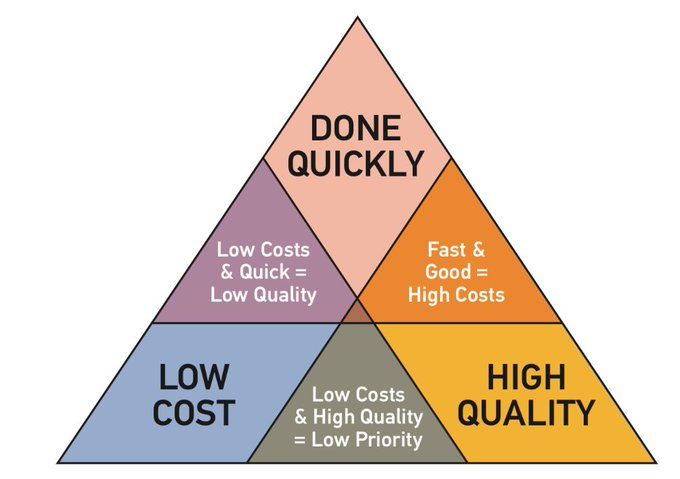The Iron Triangle: A CTO's Perspective on Modern Project Management

Introduction
As a Chief Technology Officer (CTO), I often encounter the long-standing belief in the "Iron Triangle" of project management. This concept posits that you can't achieve high quality, fast delivery, and low cost simultaneously asserting that enhancing one element invariably compromises the others. However, in our current era of technological advancement and optimized workflows, I believe this notion is increasingly outdated. By leveraging modern tools, streamlined processes, and strategic management, it is possible to overcome the constraints of the Iron Triangle.
1. Leveraging Advanced Technologies for Enhanced Productivity
In my role, I've seen firsthand how tools like ChatGPT and other AI-driven solutions have transformed productivity. These technologies automate repetitive tasks, provide intelligent insights, and facilitate faster project completion without compromising on quality. For instance, AI can analyze vast amounts of data to offer predictive analytics, streamline workflows, and even automate code generation, leading to substantial time and cost savings. This technological integration enables us to achieve a harmonious balance between quality, speed, and cost-effectiveness.
2. Harnessing Expertise and Experience for Process Optimization
Our team's collective expertise and experience play a crucial role in optimizing project processes. Skilled professionals with deep domain knowledge can foresee potential challenges and implement best practices, ensuring that projects are executed efficiently. Continuous learning and staying abreast of emerging methodologies further enhance our ability to deliver exceptional results. By fostering a culture of expertise and continuous improvement, we can streamline processes, reduce costs, and maintain high standards of quality.
3. Utilizing Reusable Components for Efficiency
One of the key strategies we employ is the use of reusable components, particularly in software development. By leveraging pre-built code libraries and modular designs, we can significantly reduce development time and costs while maintaining high quality. These reusable components are thoroughly tested and proven, ensuring reliability and performance. This approach exemplifies how modern project management can transcend the limitations of the Iron Triangle, allowing us to deliver robust solutions quickly and cost-effectively.
4. Implementing Agile and Focused Project Management
Adopting agile methodologies has been instrumental in achieving quick and cost-effective development without sacrificing quality. Agile practices emphasize iterative progress, continuous feedback, and adaptive planning, enabling our teams to respond swiftly to changes and deliver high-quality outcomes within budget. By breaking projects into smaller, focused increments, we can ensure that each phase is completed efficiently and to the highest standards.
5. Streamlining Decision-Making Processes
In our organization, we prioritize streamlined decision-making processes to enhance project efficiency. By minimizing unnecessary hierarchies and empowering teams to make quick decisions, we foster a dynamic and responsive work environment. This approach reduces delays and cuts costs while ensuring that we maintain high-quality deliverables. Fast, informed decision-making is a cornerstone of our strategy to challenge the constraints of the Iron Triangle.
Conclusion
While the Iron Triangle may still hold true in some scenarios, its rigid constraints are increasingly being challenged by modern advancements. As a CTO, I have seen how tools like ChatGPT, combined with expertise and experience, reusable components, agile methodologies, and streamlined decision-making processes, can collectively enable us to achieve high quality, speed, and cost-effectiveness. The key lies in leveraging these advancements to create a more agile, efficient, and innovative approach to project management.
FAQs
What is the Iron Triangle in project management?
The Iron Triangle, or Triple Constraint, refers to the project management concept that you can only prioritize two out of three elements: quality, speed, and cost.
How do modern tools like ChatGPT challenge the Iron Triangle?
Tools like ChatGPT enhance productivity by automating tasks and providing intelligent insights, enabling projects to be completed faster, cheaper, and with high quality.
Can expertise and experience negate the constraints of the Iron Triangle?
Yes, experienced professionals can optimize processes, reduce costs, and maintain quality, effectively balancing the elements of the Iron Triangle.
What role do reusable components play in modern project management?
Reusable components, such as code libraries, reduce development time and costs while ensuring high-quality standards, challenging the traditional constraints of the Iron Triangle.
How does agile project management impact the Iron Triangle?
Agile methodologies promote iterative progress and adaptive planning, allowing for quick, cost-effective development without sacrificing quality, thereby challenging the Iron Triangle's limitations.